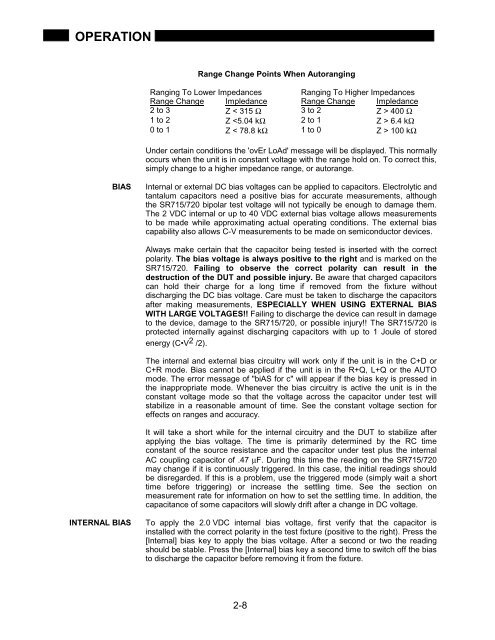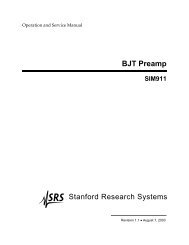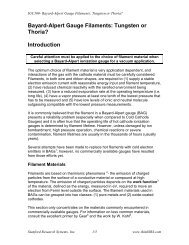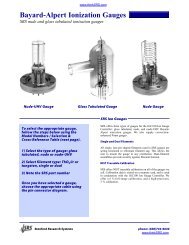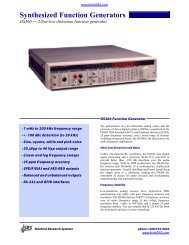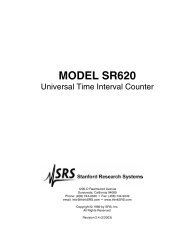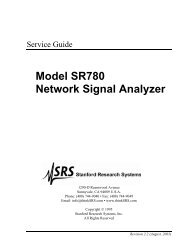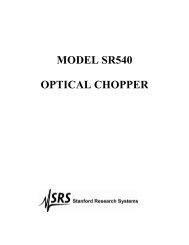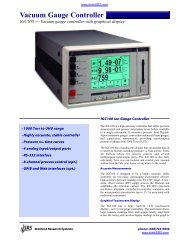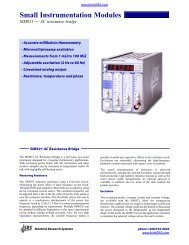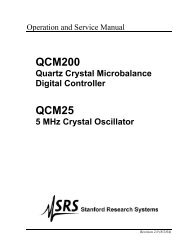Model SR715 Model SR720 LCR Meters
Model SR715 Model SR720 LCR Meters
Model SR715 Model SR720 LCR Meters
- No tags were found...
You also want an ePaper? Increase the reach of your titles
YUMPU automatically turns print PDFs into web optimized ePapers that Google loves.
OPERATIONRange Change Points When AutorangingRanging To Lower Impedances Ranging To Higher ImpedancesRange Change Impledance Range Change Impledance2 to 3 Z < 315 Ω 3 to 2 Z > 400 Ω1 to 2 Z 6.4 kΩ0 to 1 Z < 78.8 kΩ 1 to 0 Z > 100 kΩUnder certain conditions the 'ovEr LoAd' message will be displayed. This normallyoccurs when the unit is in constant voltage with the range hold on. To correct this,simply change to a higher impedance range, or autorange.BIASInternal or external DC bias voltages can be applied to capacitors. Electrolytic andtantalum capacitors need a positive bias for accurate measurements, althoughthe <strong>SR715</strong>/720 bipolar test voltage will not typically be enough to damage them.The 2 VDC internal or up to 40 VDC external bias voltage allows measurementsto be made while approximating actual operating conditions. The external biascapability also allows C-V measurements to be made on semiconductor devices.Always make certain that the capacitor being tested is inserted with the correctpolarity. The bias voltage is always positive to the right and is marked on the<strong>SR715</strong>/720. Failing to observe the correct polarity can result in thedestruction of the DUT and possible injury. Be aware that charged capacitorscan hold their charge for a long time if removed from the fixture withoutdischarging the DC bias voltage. Care must be taken to discharge the capacitorsafter making measurements, ESPECIALLY WHEN USING EXTERNAL BIASWITH LARGE VOLTAGES!! Failing to discharge the device can result in damageto the device, damage to the <strong>SR715</strong>/720, or possible injury!! The <strong>SR715</strong>/720 isprotected internally against discharging capacitors with up to 1 Joule of storedenergy (C•V 2 /2).The internal and external bias circuitry will work only if the unit is in the C+D orC+R mode. Bias cannot be applied if the unit is in the R+Q, L+Q or the AUTOmode. The error message of "biAS for c" will appear if the bias key is pressed inthe inappropriate mode. Whenever the bias circuitry is active the unit is in theconstant voltage mode so that the voltage across the capacitor under test willstabilize in a reasonable amount of time. See the constant voltage section foreffects on ranges and accuracy.It will take a short while for the internal circuitry and the DUT to stabilize afterapplying the bias voltage. The time is primarily determined by the RC timeconstant of the source resistance and the capacitor under test plus the internalAC coupling capacitor of .47 µF. During this time the reading on the <strong>SR715</strong>/720may change if it is continuously triggered. In this case, the initial readings shouldbe disregarded. If this is a problem, use the triggered mode (simply wait a shorttime before triggering) or increase the settling time. See the section onmeasurement rate for information on how to set the settling time. In addition, thecapacitance of some capacitors will slowly drift after a change in DC voltage.INTERNAL BIASTo apply the 2.0 VDC internal bias voltage, first verify that the capacitor isinstalled with the correct polarity in the test fixture (positive to the right). Press the[Internal] bias key to apply the bias voltage. After a second or two the readingshould be stable. Press the [Internal] bias key a second time to switch off the biasto discharge the capacitor before removing it from the fixture.2-8


